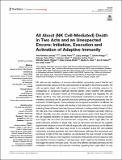Por favor, use este identificador para citar o enlazar a este item:
http://hdl.handle.net/10261/272628COMPARTIR / EXPORTAR:
 SHARE
BASE SHARE
BASE
|
|
| Visualizar otros formatos: MARC | Dublin Core | RDF | ORE | MODS | METS | DIDL | DATACITE | |

| Título: | All about (NK cell-mediated) death in two acts and an unexpected encore: initiation, execution and activation of adaptive immunity |
Autor: | Ramírez-Labrada, Ariel; Pesini, Cecilia; Santiago, Llipsy CSIC ORCID; Hidalgo, Sandra; Calvo Pérez, Adanys; Oñate, Carmen; Andrés Tovar, Alejandro; Garzón Tituaña, Marcela; Uranga Murillo, Iratxe; Arias, Maykel CSIC ORCID; Gálvez Buerba, Eva Mª CSIC ORCID ; Pardo, Julián | Palabras clave: | NK cells Cell death Granzymes Perforin Granule exocytosis Death receptors Immunological cell death |
Fecha de publicación: | 16-may-2022 | Editor: | Frontiers Media | Citación: | Frontiers in Immunology 13: 896228 (2022) | Resumen: | NK cells are key mediators of immune cell-mediated cytotoxicity toward infected and transformed cells, being one of the main executors of cell death in the immune system. NK cells recognize target cells through an array of inhibitory and activating receptors for endogenous or exogenous pathogen-derived ligands, which together with adhesion molecules form a structure known as immunological synapse that regulates NK cell effector functions. The main and best characterized mechanisms involved in NK cell-mediated cytotoxicity are the granule exocytosis pathway (perforin/granzymes) and the expression of death ligands. These pathways are recognized as activators of different cell death programmes on the target cells leading to their destruction. However, most studies analyzing these pathways have used pure recombinant or native proteins instead of intact NK cells and, thus, extrapolation of the results to NK cell-mediated cell death might be difficult. Specially, since the activation of granule exocytosis and/or death ligands during NK cell-mediated elimination of target cells might be influenced by the stimulus received from target cells and other microenvironment components, which might affect the cell death pathways activated on target cells. Here we will review and discuss the available experimental evidence on how NK cells kill target cells, with a special focus on the different cell death modalities that have been found to be activated during NK cell-mediated cytotoxicity; including apoptosis and more inflammatory pathways like necroptosis and pyroptosis. In light of this new evidence, we will develop the new concept of cell death induced by NK cells as a new regulatory mechanism linking innate immune response with the activation of tumour adaptive T cell responses, which might be the initiating stimulus that trigger the cancer-immunity cycle. The use of the different cell death pathways and the modulation of the tumour cell molecular machinery regulating them might affect not only tumour cell elimination by NK cells but, in addition, the generation of T cell responses against the tumour that would contribute to efficient tumour elimination and generate cancer immune memory preventing potential recurrences. | Descripción: | 3 figures. | Versión del editor: | https://dx.doi.org/10.3389/fimmu.2022.896228 | URI: | http://hdl.handle.net/10261/272628 | DOI: | 10.3389/fimmu.2022.896228 | E-ISSN: | 1664-3224 |
| Aparece en las colecciones: | (ICB) Artículos |
Ficheros en este ítem:
| Fichero | Descripción | Tamaño | Formato | |
|---|---|---|---|---|
| fimmu-13-896228.pdf | Artículo | 2,08 MB | Adobe PDF |  Visualizar/Abrir |
CORE Recommender
SCOPUSTM
Citations
2
checked on 16-feb-2023
WEB OF SCIENCETM
Citations
3
checked on 26-mar-2023
Page view(s)
62
checked on 24-abr-2024
Download(s)
94
checked on 24-abr-2024
Google ScholarTM
Check
Altmetric
Altmetric
Este item está licenciado bajo una Licencia Creative Commons



